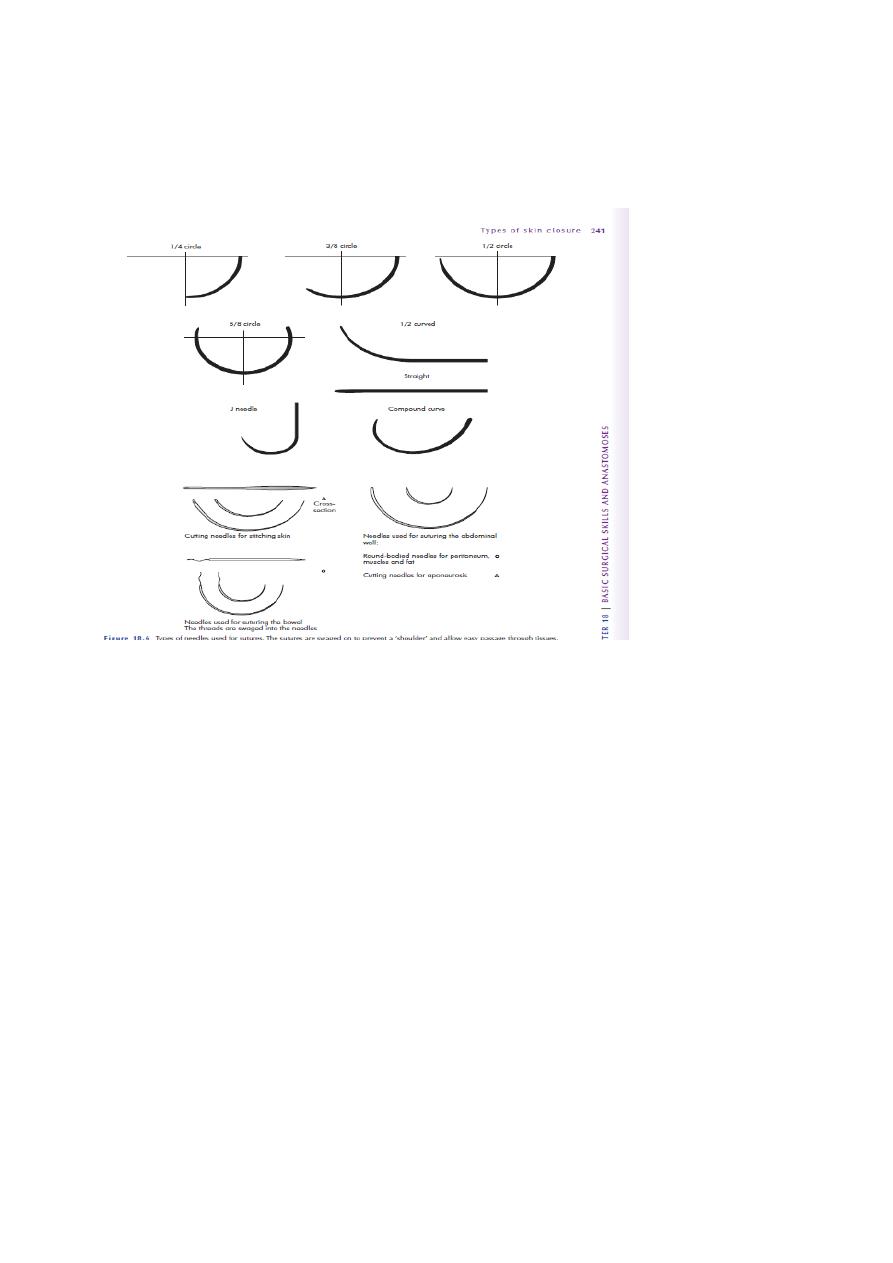
1
Fifth stage
Plastic Surgery
Lec-1
.د
بسام
24/4/2016
Suture materials
History:-
-traumatic and surgical wounds were closed in 3000 BC by the Egyptians (Thorn & needles).
-adhesive linen strip.
- Indian surgeons were using horsehair, cotton and leather sutures.
-in 19
th
century both silk &catgut became popular (can be sterilized).
-recently natural materials replaced by polymeric synthetic materials that cause minimal
inflammatory reaction.
-They can be manufactured as monofilament or braided.
-
It can be coated with wax ,silicon or poly butyrate to run smoothly &to knot securely.
-
It can be impregnated with antiseptics to aid in prevention of postoperative infection
(absorbable materials).
- Suture diameter varies from 0.02 to 0.8 mm.
-
The finest suture material that will hold the wound secure without it breaking or
“cheese wiring "through the wound should be chosen.
-
The amount of suture material used should be kept to a minimum to reduced
bacterial colonization.
-
-it can be anidus for infection &knots can be the focus for persistence &chronic
inflammatory reaction(suture knot sinus)
Selection of suture materials:
-the choice of suture materials should be based on the known physical &biological
characteristics of the suture material and the healing properties of the sutured tissue.
Factors affect selection includes:-
1-Adequate tensile strength.
2- should hold the tissue together safely.
3- should be no stronger than sutured tissue.

2
4- secured knots to prevent slippage of suture material which can be affected by :
a-type of suture material.
b-length of the cut end.
5-easier to handle.
6- less tissue reaction.
7- condition of sutured tissue( dirty, contaminated or infected wound).
Classification:
1-Non absorbable material:-
The integrity of some synthetic non absorbable materials in holding healed tissue can last
indefinitely.
Many are monofilament and makes knots less likely to be a nidus for infection but require
more skill in tying secure knots.
A-Natural:-
1-silk:
Types: braided or twisted multifilament, coated with wax or silicon or uncoated, easy
to handle with excellent knot.
Material: protein from silk worm.
Tensile strength:80-100%by 6 months
Absorption rate: slowly over 1-2 years.
Tissue reaction: moderate –high.
Contraindication: -vascular prosthesis.
-tissue require prolong approximation.
-risk of infection.
Uses: skin closure and ligation.
increasingly not recommended.
2-Linin:
Types: twisted.
Material: long staple flax fiber.
T.S.: stronger when wet .
loses 60% at 6 months&30%remain at 2 years.
Absorption: remain encapsulated in body tissue.
Tissue reaction: moderate.

3
Contra indication :vascular prosthesis.
Uses: ligation &GIT surgery (no longer use).
B-synthetics:-
1-stainless steel:
Types: mono or multifilament/poor handling.
Material: iron ,nickle ,chromium alloy.
T.s : infinite
Absorption: remain encapsulated in body tissue.
Tissue reaction: minimal
Contra indication: sensitivity to nickle.
when MRI going to be used.
Uses: bone surgery( sternotomy),ligament surgery.
2-Nylon:
Types: mono or multifilament braided or not,dyed or not.
Material: polyamid polymer(strong and smooth).
T.s : loses 15-20% per year.
Absorption: degrades &absorbed in 2 years.
Tissue reaction: low.
Contra indication: none.
Uses: cutaneous surgery (plastic surgery), opthalmic surgery,
microsurgery, hernia, abdominal wall & general surgery.
3-polyester:
Types: mono or multifilament, (dacron,mersillen, teflon, silicon, ethibond )
Material: polyester(polyethelen(require 5 throw knot).
T.s : infinite.
Absorption: remain encapsulated in body tissue.
Tissue reaction: low.
Contra indication: none.
Uses: cardiovascular surgery,opthalmic surgery,
general surgery,plastic surgery,
excellent for facial closure.

4
4-polypropylene:
Types: monofilament dyed or not.
Material: polymer of propylene.
T.s : infinite.
Absorption: remain encapsulated in body tissue.
Tissue reaction: low.
Contra indication: none.
Uses: cardiovascular surgery ,plastic & ophthalmic surgery, general surgery,
subcuticular skin closure.
2-Absorbable suture material
It implies absorption &eventual disappearance of the Suture from tissue implantation site.
A-Natural:
1-catgut:-
It acts as active foreign body and may interfere with tissue healing ,with risk of prion
transmission .
its avoid discomfort with suture removal (child)and have low incidence of stitch
mark, and superior handling.
a-plain:
Material: collagen derived from healthy sheep or cattle.
T.s: lost withen 7-10 days(not recommended)
Absorbtion rate: phagocytosis and enzymatic degradation.
Tissue raction: high.
Contraindications: 1-slowly healed tissue.
2-tissue require prolong support.
Uses: 1-ligation of superficial vessels.
2-subcutaneous tissue, stoma .
b- chromic:
Material: collagen from sheep or cattle tanned with chromium salt.
T.S.: lost within 21-28 days .
Absorption: phagocytosis and degradation (90 days).
Tissue reaction: moderate.
Contra indication: as with plain.

5
Uses: as with plain.
B-synthetics
1-Poly glactin (vicryl):
Types: braided multi filament.
Material: copolymer of lactid coated with polyglactin.
T.S.: 60% remain at 2 weeks &30% at 3 weeks.
Absorption: hydrolysis 5-6 weeks (minimal),60-90 days complete absorption.
Tissue reaction: mild.
Contra indication: tissue require prolong approximation under tension.
Uses: ligation &GIT surgery ,ophthalmic surgery ,wound closure.
2-polyglyconate(maxon):
Types: monofilament.
Material: copolymer of glycolic acid.
T.S.: 70% remain at 2 weeks &55% at 3 weeks .
Absorption: hydrolysis(minimal) at 8-9weeks,complete at 180 days.
Tissue reaction: mild.
Contra indication: tissue require prolong
approximation under stress.
Uses: alternative to vicryl & PDS
3- poly glycolic acid(dexon):
Types: braided multifilament.
Material: polymer of polyclycolic acid.
T.S.: 20% remain at 3 weeks .
Absorption: hydrolysis,complet absorbtion at 60-90 days.
Tissue reaction: minimal.
Contra indication: tissue require prolong
approximation under stress.
Uses: as other non absorbable .
4-poly diaxanon (PDS):
Types: monofilament.
Material: polyster polymer.

6
T.S.: 14% remain at 8 weeks .
Absorption: complet absorption in 180 days.
Tissue reaction: mild.
Contra indication: in heart valve.
Uses: as other absorbable.
Metal clips:
-For skin.
advantages:
1- quick &accurate closure.
2- save time.
3- easy to remove.
4- low infection rate .
5- acceptable scar.
disadvantages:
1- expensive.
2- disposable.
3- skin edge overlaps.
Others:
1- tissue glue
2- steri strips
